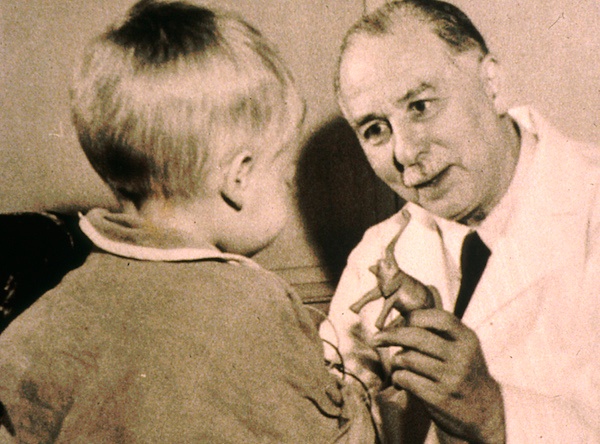By Martin Braendle
In his book, The Emperor of All Maladies, Siddhartha Mukherjee tells the story of one of the turning points in the history of cancer medicine. A turning point that he dates to May 1947. In this two-part article we will look at how cancer research has been transformed by fundraising.
Dr. Sidney Farber, physician at the Children's Hospital of Boston was instrumental in early leukemia research.
A deadly taboo
Cancer was a fatal disease and as a subject of discussion, it was rarely mentioned among close friends, least of all at polite social gatherings. Cancer was an ugly disease that appeared to harvest lives regardless of the individual’s background, lifestyle, or social stature. Its victims were carved up in radical surgical procedures or subjected to experimental chemical trials with little or no understanding of the underlying mechanisms. After a brief period of remission, most patients succumbed to new tumors, some far more aggressive than their predecessors. Research was performed by a handful of dedicated doctors who were nameless, faceless, and relegated to the basements of hospitals to perform research with dubious outcomes.
The baby in a basket
If cancer ever was to have a future as a disease to be tackled seriously, it needed serious funding. Cancer had to become a disease that people were not afraid to talk about in public. And the focus had to be on a patient that nobody could deny deserved all the help in the world.
The story begins 19 years earlier, with a baby in a basket.
The baby girl was abandoned on a seat in the Sheridan Square Film Theater in Pittsburgh at the start of the Depression of 1928. The note attached to the baby read:
“Please take care of my baby. Her name is Catherine. I can no longer take care of her. I have eight others. My husband is out of work. She was born on Thanksgiving Day. I have always heard of the goodness of show business and I pray to God that you will look after her. Signed, a heartbroken mother.”
The baby was named Catherine Variety Sheridan, her surname after the theater where she was found, and her middle name after The Variety Club, an association of actors, producers, directors, writers, and film theater owners that adopted Catherine as their ward.
The media exposure from the adoption of baby Catherine was far greater than the members of the Variety Club could ever have dreamed. During the war years, the entertainment industry had boomed and Hollywood realized that they had earned the adoring, if somewhat fickle, goodwill of the general public. The Variety Club redefined itself as a philanthropic organization that was keen to reinforce the idea of ‘the goodness of show business’.
Every dime counts
The Variety Club was inspired by the March of Dimes, a campaign initiated by the actor Eddie Cantor when Franklin D. Roosevelt was reelected President. In 1936, Roosevelt, himself a polio victim, established the National Foundation of Infantile Paralysis. Polio research and patient care received a massive boost in funding thanks to the nationwide campaigning efforts of the March of Dimes, which reached out through the radio waves into the living rooms of private homes across America. Dimes in envelopes flooded into the White House from factory workers, housewives, schoolchildren, and Girl Scouts. In the first year alone, 2,680,000 dimes were collected.
By the late 1940’s, John Enders had succeeded in cultivating the first live polio virus in the lab. The development of the polio vaccine was a direct effect of the public funding initiative. In 1938, FDR focused on cancer, and signed legislation that gave birth to the National Cancer Institute. Its initial budget was $400,000.
Surviving leukemia
Bill Koster of the Variety Club of New England began the search for a new cause that his club could own. He had visited many hospital labs and found medical scientists buried under piles off papers, but none of them had the ambition to think big. Until he met Dr. Sidney Farber.
Farber was at Children’s Hospital Boston working on childhood leukemia, a disease that had confounded the medical community—no treatment had been identified that extended the survival of patients. Farber had been experimenting with a new drug, an antifolate called aminopterin. Farber had demonstrated the first signs of partial remission of pediatric leukemia by aminopterin in a 4-year-old girl. Empowered by a rare positive result, Farber was now obsessed by his vision of a hospital dedicated to the research of childhood leukemia.
Koster had found his man. Together, Koster and Farber began to hatch plans to make the hospital a reality. In 1948, they launched the Children's Cancer Research Fund. Their first raffle raised an impressive $45,456, but hardly enough to open a hospital. Koster recalled the success of the Catherine Sheridan campaign and convinced Farber that they needed a poster child, a mascot for childhood leukemia. Putting a face to cancer would be a powerful driving force in fundraising, as we will see in Part II of this series.
Next: The very short history of cancer research - Part II
About the author

Martin Braendle
Martin Braendle has a broad background in communications, holistically covering all areas from investor to product communications. He is passionate about the life sciences industry and the trained economist can’t think of any better motivation for work than at the end of the day helping people and improving health care. After helping biotech companies to develop new drugs for many years, he joined Tecan in 2008. At Tecan Group, Martin is a VP and member of the Extended Management Board.











